Recently published research has demonstrated that wearing superfine Merino wool next to the skin is beneficial for eczema sufferers. This adds to a growing number of research findings supporting the wellbeing benefits of superfine Merino wool.
The research has shown that wearing superfine Merino wool significantly improves the severity and symptoms of this chronic skin condition, challenging misconceptions that all wool is prickly and itchy.
What is eczema?
Many of us have broken out in a rash at least once in our lives – heat rash, stress rash, or some other nasty. But spare a thought for those who suffer from constant breakouts, or for babies too young to understand what this intense itchy, dry skin is. Eczema, also known as Atopic Dermatitis (AD), now affects up to 28% of children. Its prevalence varies geographically and is increasing in many countries. Eczema sufferers have dysfunctional skin that dries out, which can lead to cracked skin, bacterial infection, redness, scratching and itching.

Eczema treatments
The most common treatments currently include the regular application of non-cosmetic moisturisers and topical steroids to reduce inflammation, as well as antibiotics to address bacterial infection. However, in a major medical breakthrough, wool has been found to be beneficial to the skin, providing a natural adjunct treatment for eczema that reduces the need for traditional medicines. Dermatologial trials have shown that adult and infant eczema sufferers who wear superfine Merino wool garments – of 17.5 microns or less – next to the skin have significantly reduced symptoms.
How wool benefits eczema patients
Whether it’s hot, cold, humid or dry, Merino wool garments are the most breathable of the common apparel types because of wool’s ability to absorb and release twice as much moisture vapour as cotton, and 30 times as much as polyester. When worn next to the skin, super fine Merino wool works as a dynamic buffer, helping to stabilise the humidity levels and temperature of the micro-climate between the fabric and the skin. It appears super fine Merino wool acts like a second skin for people whose ‘first’ skin is too dry.
Wool works to buffer the dynamic micro-climate between the fabric and the skin
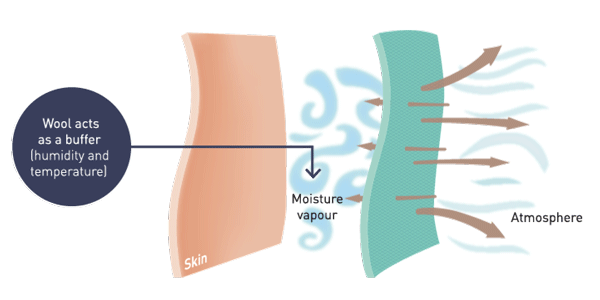
Eczema sufferers have especially sensitive skin and an Australian study at the Murdoch Children’s Research Institute has shown that wool garments made from soft superfine Merino wool garments were well tolerated by participants in the study and reduced their eczema symptoms. Note: the garments must have a mean fibre diameter of 17.5 micron or finer. The below graph demonstrates how wool is one of the best of the common apparel fibres.
Moisture vapour uptake of wool and other fibres
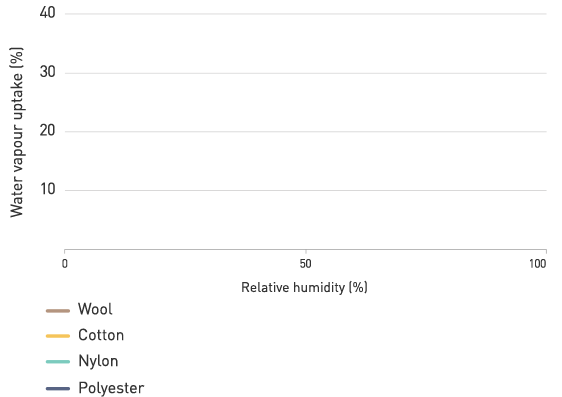
The evidence: studies show a reduction in eczema symptoms with wool
Three recent dermatology trials have shown that infant, adolescent and adult eczema sufferers have reported reduced symptoms when wearing superfine Merino wool garments next to the skin. They have shown benefits of wearing superfine Merino wool garments with a mean fibre diameter ≤17.5 mm for at least 6 hours/day for 6 weeks on the severity and symptoms of Atopic Dermatitis.
Across the three studies, wearing superfine Merino wool base-layer garments was associated with significant improvements in SCORAD, EASI and ADSI scores. Furthermore, patients reported significant reductions in symptoms of itchy, scratchy and painful skin and that bleeding, weeping/oozing, flaking and dry or rough skin decreased.
These benefits on symptoms translated into significant improvements in quality of life in both children and adults, reported using the IDQOL and DLQI, respectively. Hear from one of the study's patients in this video.
STUDY 1: Wool Clothing Recommended For Infants With Eczema (MCRI, Melbourne)
The theory that superfine Merino wool worn next to the skin could benefit eczema sufferers was put to the test in this study led by Associate Professor John Su at Murdoch Children’s Research Institute. The study showed that superfine Merino wool clothing reduced the severity of paediatric mild-moderate atopic dermatitis as compared to cotton clothing.
The graph below shows the reduction in eczema symptoms over a six-week period while wearing wool clothing and the subsequent increase in symptoms on resuming cotton clothing.
Determining effects of superfine sheep wool in infantile eczema
WOOL vs COTTON
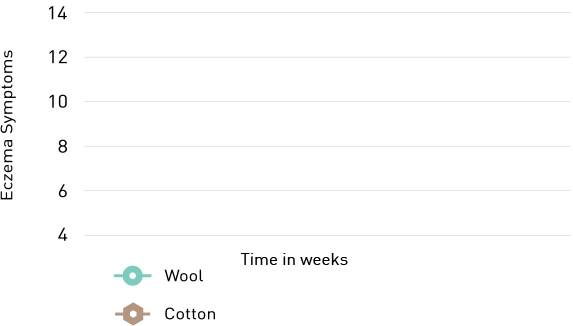
Published in the British Journal of Dermatology, this study challenges the misconception that all wool is to be avoided by children with eczema. The study concluded that traditional management guidelines classing all wool-based clothing as irritants should be modified to include superfine Merino wool as a recommended clothing choice in childhood atopic dermatitis.
STUDY 2: Substantial Reductions In Symptoms For Adolescents And Adults With Eczema (QIDERM, Brisbane)
A study of adolescent and adult sufferers of eczema in Brisbane, led by Dr Lynda Spelman at the Queensland Institute of Dermatology (QIDerm), has also demonstrated the beneficial effects of wearing superfine Merino wool next to the skin. Published in the Journal of Scientific & Technical Research, the study concluded superfine Merino wool base-layer garments could provide a valuable adjunct therapy in the management of atopic dermatitis. “We have seen substantial reductions in skin dryness, redness and itchiness, and in the measured area of inflammation,” said Dr Spelman.
STUDY 3: Significant Improvements Seen In Mean Eczema Area And Severity Index Scores (Division Of Dermatology, University Of Louisville, Kentucky, USA)
A study of child and adult sufferers of eczema by the Division of Dermatology, University of Louisville, Kentucky has also demonstrated the beneficial effects of wearing superfine Merino wool next to the skin. The study, published in the medical journal Dermatitis and led by Professor Joe Fowler, confirmed that wearing Merino wool clothing compared to standard clothing provided improvements in severity of atopic dermatitis as well as quality of life in atopic dermatitis patients. “This study and those of Professor John Su and Dr Lynda Spelman show that fine-diameter Merino wool clothing should be considered acceptable for people with eczema and seems to be therapeutic to patients with mild to moderate atopic dermatitis,” Professor Fowler said.
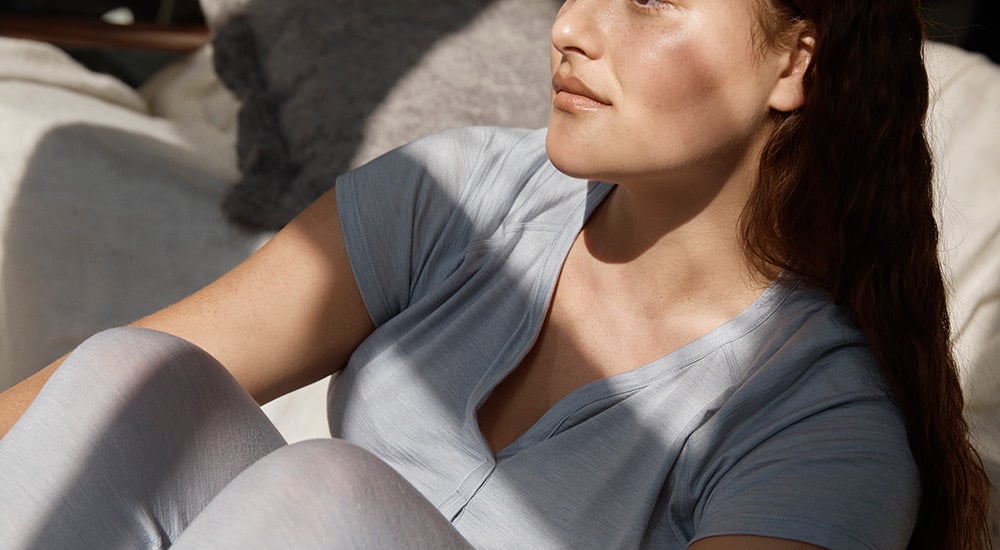
What do fibre diameters mean?
Studies have shown that perceptions of prickle from clothing increase as the fibre diameter increases and may be an important factor for those with sensitive skin, such as those living with AD.
We now better understand the role of wool fibre diameters. In fact, wool garments with a mean diameter of ≤17.5 mm have shown potential benefits in studies assessing wool’s impact on AD symptoms.
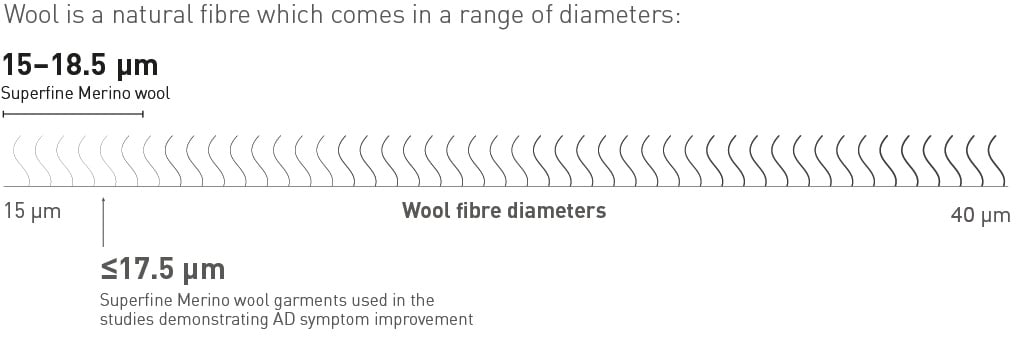
Wool is not an allergen
A highly esteemed group of medical professionals from across the world has reviewed research papers published during the past 100 years to critically assess scientific studies claiming wool causes allergy. The group has now published a paper Debunking the Myth of Wool Allergy with the primary conclusion there is no credible evidence wool is an allergen. It found that if a fabric does cause sensations of itch and prickle on the skin then it is because of the large diameter of the fibres and not due to the fibre type being wool.
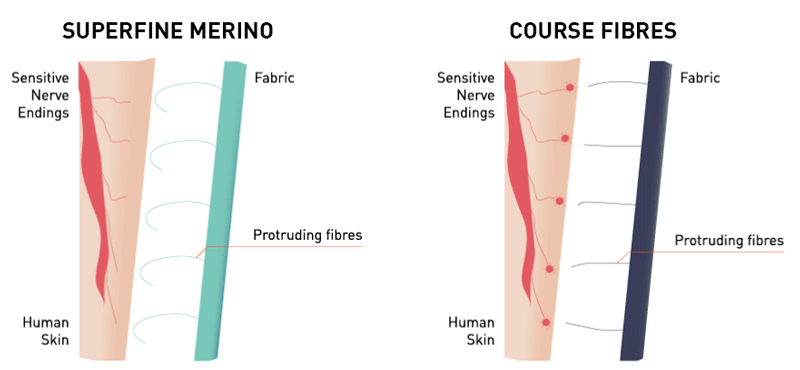
Superfine and ultrafine Merino fibres bend easily, causing minimal or no skin irritation. In comparison, coarse fibres like acrylic and nylon have less tendency to bend, causing skin irritation.
Where to find superfine Merino wool
There is a growing desire among eczema sufferers or parents of children with eczema for natural approaches to help support treatment. Superfine Merino wool (≤18.5 mm) is increasingly available and is suitable for wearing directly against the skin.
Research
Wool promotes a better night’s sleep
Falling asleep may be easier than you know. These days, more than ever, it's important to invest in sleep health and get the most from your waking hours.






